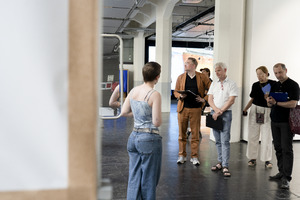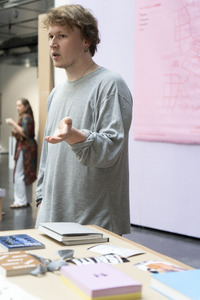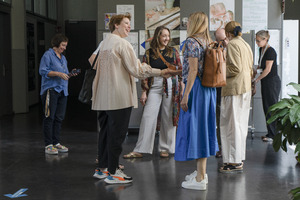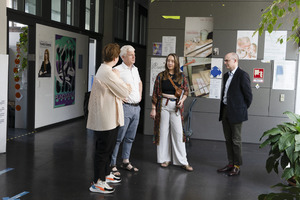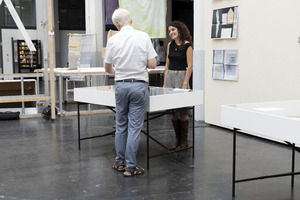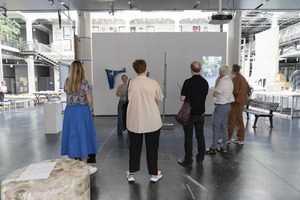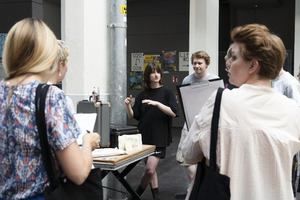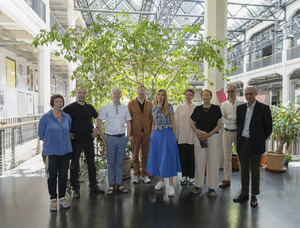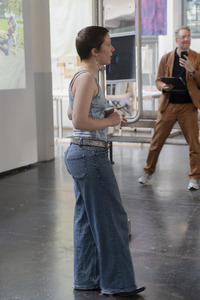"Website und Online-Angebote der HfG"
| Begriff | Website und Online-Angebote der HfG |
| Metakey | Freigabe Nutzung HfG (rights:usage_hfg) |
| Typ | Keyword |
| Vokabular | Rechte |
1767 Inhalte
- Seite 1 von 148
Jury Tour 2024
- Titel
- Jury Tour 2024
- Titel
- Jury Tour 2024
- Urheberrechtshinweis
- © Staatliche Hochschule für Gestaltung Karlsruhe photo: Jehad Othman
- Rechtsschutz/Lizenz
- Freigabe Nutzung HfG
- Importiert am
- 22.07.2024
- Übergeordnete Sets
- 1
Jury Tour 2024
- Titel
- Jury Tour 2024
- Titel
- Jury Tour 2024
- Urheberrechtshinweis
- © Staatliche Hochschule für Gestaltung Karlsruhe photo: Jehad Othman
- Rechtsschutz/Lizenz
- Freigabe Nutzung HfG
- Importiert am
- 22.07.2024
- Übergeordnete Sets
- 1
Jury Tour 2024
- Titel
- Jury Tour 2024
- Titel
- Jury Tour 2024
- Urheberrechtshinweis
- © Staatliche Hochschule für Gestaltung Karlsruhe photo: Jehad Othman
- Rechtsschutz/Lizenz
- Freigabe Nutzung HfG
- Importiert am
- 22.07.2024
- Übergeordnete Sets
- 1
Jury Tour 2024
- Titel
- Jury Tour 2024
- Titel
- Jury Tour 2024
- Urheberrechtshinweis
- © Staatliche Hochschule für Gestaltung Karlsruhe photo: Jehad Othman
- Rechtsschutz/Lizenz
- Freigabe Nutzung HfG
- Importiert am
- 22.07.2024
- Übergeordnete Sets
- 1
Jury Tour 2024
- Titel
- Jury Tour 2024
- Titel
- Jury Tour 2024
- Urheberrechtshinweis
- © Staatliche Hochschule für Gestaltung Karlsruhe photo: Jehad Othman
- Rechtsschutz/Lizenz
- Freigabe Nutzung HfG
- Importiert am
- 22.07.2024
- Übergeordnete Sets
- 1
Jury Tour 2024
- Titel
- Jury Tour 2024
- Titel
- Jury Tour 2024
- Urheberrechtshinweis
- © Staatliche Hochschule für Gestaltung Karlsruhe photo: Jehad Othman
- Rechtsschutz/Lizenz
- Freigabe Nutzung HfG
- Importiert am
- 22.07.2024
- Übergeordnete Sets
- 1
Jury Tour 2024
- Titel
- Jury Tour 2024
- Titel
- Jury Tour 2024
- Urheberrechtshinweis
- © Staatliche Hochschule für Gestaltung Karlsruhe photo: Jehad Othman
- Rechtsschutz/Lizenz
- Freigabe Nutzung HfG
- Importiert am
- 22.07.2024
- Übergeordnete Sets
- 1
Jury Tour 2024
- Titel
- Jury Tour 2024
- Titel
- Jury Tour 2024
- Urheberrechtshinweis
- © Staatliche Hochschule für Gestaltung Karlsruhe photo: Jehad Othman
- Rechtsschutz/Lizenz
- Freigabe Nutzung HfG
- Importiert am
- 22.07.2024
- Übergeordnete Sets
- 1
Jury Tour 2024
- Titel
- Jury Tour 2024
- Titel
- Jury Tour 2024
- Urheberrechtshinweis
- © Staatliche Hochschule für Gestaltung Karlsruhe photo: Jehad Othman
- Rechtsschutz/Lizenz
- Freigabe Nutzung HfG
- Importiert am
- 22.07.2024
- Übergeordnete Sets
- 1
Jury Tour 2024
- Titel
- Jury Tour 2024
- Titel
- Jury Tour 2024
- Urheberrechtshinweis
- © Staatliche Hochschule für Gestaltung Karlsruhe photo: Jehad Othman
- Rechtsschutz/Lizenz
- Freigabe Nutzung HfG
- Importiert am
- 22.07.2024
- Übergeordnete Sets
- 1
Jury Tour 2024
- Titel
- Jury Tour 2024
- Titel
- Jury Tour 2024
- Urheberrechtshinweis
- © Staatliche Hochschule für Gestaltung Karlsruhe photo: Jehad Othman
- Rechtsschutz/Lizenz
- Freigabe Nutzung HfG
- Importiert am
- 22.07.2024
- Übergeordnete Sets
- 1
Jury Tour 2024
- Titel
- Jury Tour 2024
- Titel
- Jury Tour 2024
- Urheberrechtshinweis
- © Staatliche Hochschule für Gestaltung Karlsruhe photo: Jehad Othman
- Rechtsschutz/Lizenz
- Freigabe Nutzung HfG
- Importiert am
- 22.07.2024
- Übergeordnete Sets
- 1


